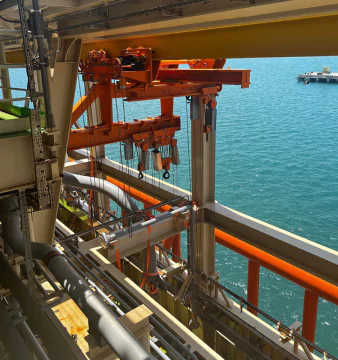
Nante Crane: Enhancing overhead Crane Efficiency in Oil & Gas
Overview of Nante Crane
Nante Crane stands as a beacon of innovation in the crane and crane components industry. As one of China’s leading designers and manufacturers, Nante Crane is dedicated to the research and development of lifting and material handling technologies. By adopting innovative ideas and designs, Nante Crane consistently develops new products and services that meet the evolving needs of its clients. With a rich history of industrial experience, Nante Crane provides high-quality lifting equipment and components that help clients reduce investment costs, improve production efficiency, and economize energy consumption.
Product Offerings
Nante Crane’s extensive product line is tailored to meet the diverse demands of various industries. Among its offerings is the Offshore Davit Crane, designed specifically for marine environments. These cranes boast advanced features such as corrosion resistance, salt spray resistance, wind and sun protection, and ease of operation.
An offshore platform crane is a special crane used in the marine environment, that is mainly installed on offshore platforms, oil platforms, or ocean ships for offshore hoisting operations. Nante can provide various types of offshore cranes, including wind power platform cranes, oil platform cranes, oil production ship cranes, and other products. Nante offshore platform crane can adapt to the harsh, complex, and changeable marine environment, and has the characteristics of simple operation, stable product performance, long service life, etc.
The Role of Cranes in the Oil and Gas Industry
Applications in Oil Rigs
Cranes play a crucial role in oil rigs by facilitating the transportation of heavy equipment and materials essential for drilling operations. Offshore cranes are specifically engineered to withstand harsh marine conditions, ensuring reliable performance even in challenging environments. Their ability to handle significant loads with precision makes them indispensable for efficient oil extraction processes.

Functionality in Gas Purification Centers
In gas purification centers, cranes contribute significantly by handling large volumes of materials required for refining processes. The precision offered by these cranes ensures that materials are moved efficiently without compromising safety or operational integrity. Their adaptability to various operational demands makes them an essential component in maintaining smooth workflows within these facilities.
Contribution to Shipping Ports
Shipping ports see advantages from utilizing cranes to load and unload cargo efficiently cranes play a crucial role in ensuring swift turnaround times at ports They excel at handling heavy loads and can operate smoothly in different weather conditions This reliability minimizes any interruptions, in shipping operations.
Engineered Transportation Solutions
In the oil and gas sector Cranes deliver transport solutions with custom features designed for needs. Be it shifting equipment offshore or moving materials over long distances. Ensuring operations run smoothly and safely.
Key Requirements for Overhead Cranes in Oil and Gas: Elevating Safety, Precision, and Adaptability
Safety First
Safety is of importance, in the oil and gas sector because of the nature of activities involved there. Strict safety protocols need to be followed for cranes to safeguard both workers and equipment from any dangers. Key elements like emergency stop functions, protection against overload, and routine maintenance routines are essential, for guaranteeing the safety of crane operations.
Load Capacity and Precision
Cranes utilized in oil and gas settings need to have load capabilities to manage equipment and materials effectively. The accuracy, in managing loads is crucial to avoid mishaps and guarantee operations. Modern control systems enable operators to handle loads reducing the risks linked to human mistakes.
Adaptability to Hazardous Environments
In the oil and gas industry, overhead cranes must be able to handle conditions, like exposure, to saltwater while still working effectively. They need to be made with materials and protective coatings to last through environmental situations.
Tailored Features for Efficiency
Efficiency plays a role in the oil and gas sectors’ success story. Crane systems with customized functionalities like automated controls and remote operation options along with designs play a role in enhancing operational efficiency. By leveraging automation technologies to decrease involvement in operations, these crane systems optimize and reduce downtime effectively.
In summary, Nante Crane’s dedication to improving the efficiency of cranes is in sync with the requirements of the oil & gas sector. By leveraging designs supported by years of expertise Nante Crane maintains its position as a leader in this field offering solutions that boost safety levels and enhance performance results in various global applications.
Enhancing Efficiency in the Oil and Gas Industry with Overhead Cranes
importance in the Oil and Gas Sector: Efficiency Redefined
In the changing world of the oil and gas industry being efficient is not a target but a must-have requirement. The use of cranes, in this field is crucial in reshaping how things operate smoothly. These cranes are key to making operations more streamlined at every step, from exploring resources to producing them. By improving how materials are handled and moving equipment around efficiently overhead cranes help cut down delays and boost productivity significantly.
Safety Amplified
Safety is of importance, in the oil and gas sector due to the machinery and risky surroundings commonly encountered in operations there. Boosted safety measures, like automated controls and emergency stop systems integrated into cranes, enhance safety standards in handling materials by enabling safe and efficient movement while reducing potential risks to both personnel and equipment.
Exploring the Types of Overhead Cranes in the Oil and Gas Industry
The Versatility of Overhead Cranes
Overhead cranes are well known for their flexibility, in managing a range of duties in the oil and gas industry sector Their ability to adjust makes them appropriate for a variety of uses such as hoisting equipment onto offshore structures or moving materials, over long distances.
Types of Overhead Cranes Used:
Bridge Crane:
Overhead cranes are frequently employed in oil refineries and petrochemical facilities for their capacity to cover areas while transporting loads efficiently and reliably due, to their sturdy design that enables them to manage bulky machinery accurately.
Gantry Cranes:
In environments, like shipyards and construction sites in the oil and gas sector; gantry cranes provide versatility due, to their ability to move easily and be relocated as needed for projects involving the transportation of materials.
Jib Cranes:
In areas or places, with overhead clearance restrictions Jib cranes offer focused lifting solutions that help improve operational efficiency due, to their ability to move materials accurately in tight spaces thanks to their compact design.
Choosing the Right Crane
Meeting the Challenge: Key Requirements for Overhead Cranes
Choosing the overhead crane is essential for addressing the obstacles presented in oil and gas activities effectively requiring careful consideration of various essential factors to guarantee top-notch performance.
Safety First:
Ensuring safety is paramount when selecting cranes for use in oil and gas settings. It’s crucial to have features, like sway technology and collision avoidance systems in place along with conducting regular maintenance checks to prevent accidents and protect the workforce.
Load Capacity and Precision:
Operating cranes, with precision is crucial to ensure safety and efficiency by allowing operators to handle heavy loads accurately and minimize the risks of mishandling machinery.
Adaptability to Hazardous Environments:
Cranes used in oil and gas settings need to be built tough to handle the conditions there. They're made with materials that resist corrosion and protective coatings to withstand challenges, like exposure, to saltwater.
Tailored Features for Efficiency:
In addition, increasing efficiency through custom features like operation options automated controls, and modular designs can also play a role in enhancing productivity levels by simplifying processes and decreasing the need for manual adjustments while also minimizing interruptions, with the integration of automation technologies.
In summary, Nante Crane’s creative strategy to improve efficiency, in cranes fits well with the requirements of the oil & gas sector. With their designs backed by years of expertise, Nante Crane remains a frontrunner in this industry providing solutions that enhance safety protocols and boost performance results in various global settings.


